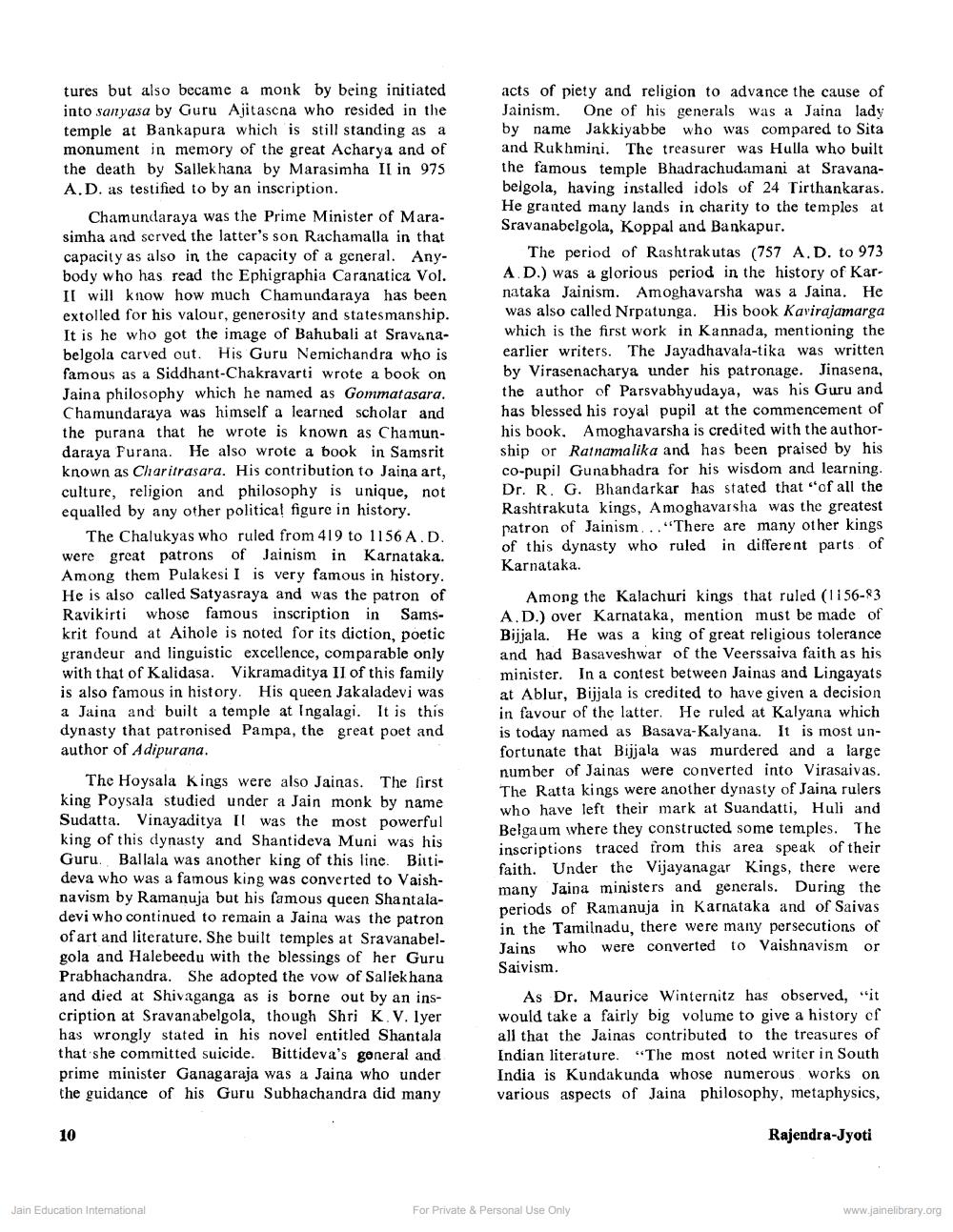________________
tures but also became a monk by being initiated into sanyasa by Guru Ajitascna who resided in the temple at Bankapura which is still standing as a monument in memory of the great Acharya and of the death by Sallekhana by Marasimha II in 975 A.D. as testified to by an inscription.
Chamundaraya was the Prime Minister of Marasimha and served the latter's son Rachamalla in that capacity as also in the capacity of a general. Anybody who has read the Ephigraphia Caranatica Vol. I will know how much Chamundaraya has been extolled for his valour, generosity and statesmanship. It is he who got the image of Bahubali at Sravanabelgola carved out. His Guru Nemichandra who is famous as a Siddhant-Chakravarti wrote a book on Jaina philosophy which he named as Gommatasara. Chamundaraya was himself a learned scholar and the purana that he wrote is known as Chamundaraya Purana. He also wrote a book in Samsrit known as Charitrasara. His contribution to Jaina art, culture, religion and philosophy is unique, not equalled by any other political figure in history.
The Chalukyas who ruled from 419 to 1156 A.D. were great patrons of Jainism in Karnataka. Among them Pulakesi I is very famous in history. He is also called Satyasraya and was the patron of Ravikirti whose famous inscription in Samskrit found at Aihole is noted for its diction, poetic grandeur and linguistic excellence, comparable only with that of Kalidasa. Vikramaditya II of this family is also famous in history. His queen Jakaladevi was a Jaina and built a temple at Ingalagi. It is this dynasty that patronised Pampa, the great poet and author of Adipurana.
acts of piety and religion to advance the cause of Jainism. One of his generals was a Jaina lady by name Jakkiyabbe who was compared to Sita and Rukhmini. The treasurer was Hulla who built the famous temple Bhadrachudamani at Sravanabelgola, having installed idols of 24 Tirthankaras. He granted many lands in charity to the temples at Sravanabelgola, Koppal and Bankapur.
The period of Rashtrakutas (757 A.D. to 973 A.D.) was a glorious period in the history of Karnataka Jainism. Amoghavarsha was a Saina. He was also called Nrpatunga. His book Kavirajamarga which is the first work in Kannada, mentioning the earlier writers. The Jayadhavala-tika was written by Virasenacharya under his patronage. Jinasena, the author of Parsvabhyudaya, was his Guru and has blessed his royal pupil at the commencement of his book. Amoghavarsha is credited with the authorship or Rainamalika and has been praised by his co-pupil Gunabhadra for his wisdom and learning. Dr. R. G. Bhandarkar has stated that of all the Rashtrakuta kings, Amoghavarsha was the greatest patron of Jainism... "There are many other kings of this dynasty who ruled in different parts of Karnataka.
The Hoysala Kings were also Jainas. The first king Poysala studied under a Jain monk by name Sudatta. Vinayaditya Il was the most powerful king of this dynasty and Shantideva Muni was his Guru. Ballala was another king of this line. Bittideva who was a famous king was converted to Vaishnavism by Ramanuja but his famous queen Shantaladevi who continued to remain a Jaina was the patron of art and literature. She built temples at Sravanabelgola and Halebeedu with the blessings of her Guru Prabhachandra. She adopted the vow of Sallek hana and died at Shivaganga as is borne out by an inscription at Sravanabelgola, though Shri K. V. lyer has wrongly stated in his novel entitled Shantala that she committed suicide. Bittideva's goneral and prime minister Ganagaraja was a Jaina who under the guidance of his Guru Subhachandra did many
Among the Kalachuri kings that ruled (1156-83 A.D.) over Karnataka, mention must be made of Bijjala. He was a king of great religious tolerance and had Basaveshwar of the Veerssaiva faith as his minister. In a contest between Jainas and Lingayats at Ablur, Bijjala is credited to have given a decision in favour of the latter. He ruled at Kalyana which is today named as Basava-Kalyana. It is most unfortunate that Bijjala was murdered and a large number of Jainas were converted into Virasaivas. The Ratta kings were another dynasty of Jaina rulers who have left their mark at Suandatti, Huli and Belgaum where they constructed some temples. The inscriptions traced from this area speak of their faith. Under the Vijayanagar Kings, there were many Jaina ministers and generals. During the periods of Ramanuja in Karnataka and of Saivas in the Tamilnadu, there were many persecutions of Jains who were converted to Vaishnavism or Saivism.
As Dr. Maurice Winternitz has observed, "it would take a fairly big volume to give a history of all that the Jainas contributed to the treasures of Indian literature. "The most noted writer in South India is Kundakunda whose numerous works on various aspects of Jaina philosophy, metaphysics,
10
Rajendra-Jyoti
Jain Education Intemational
For Private & Personal Use Only
www.jainelibrary.org




